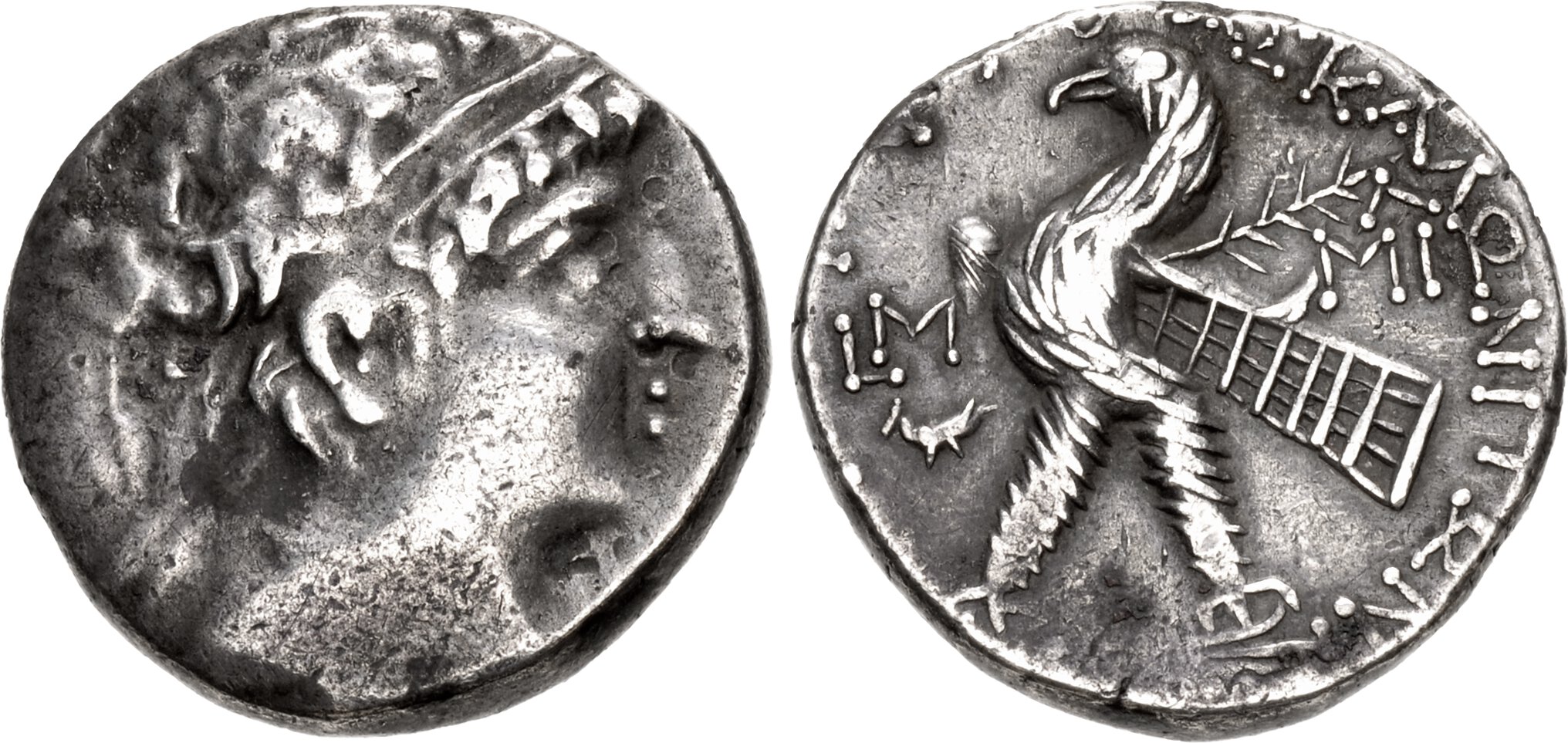Ascalon (Ptolemy XII), silver, tetradrachms (Antiochus/eagle) (84-54 BCE) Callataÿ
From SILVER
84 BCE - 54 BCE Silver 15,702 kg
Description
| ObverseInscription or printing placed on the obverse.: | Diademed and draped bust of Antiochos VIII right |
| ReverseInscription or printing placed on the reverse.: | (Greek).Eagle standing left on thunderbolt, to left, LM (date) above dove standing left, to right, Λ above MI |
Mint and issuing power
| MintIdentifies the place of manufacture or issue of a numismatic object.: | Ascalon | Ancient regionAncient region.: | Phoenicia | Modern countryModern country: Israel | AuthorityIdentifies the issuing power. The authority can be "pretended" when the name or the portrait of X is on the coin but he/she was not the issuing power. It can also be "uncertain" when there is no mention of X on the coin but he/she was the issuing power according to the historical sources: | Seleucid Dynasty (312-63 BC) |
Chronology
| FromIdentifies the initial date in a range assigned in a numismatic context. | 84 BCE | toIdentifies the final date in a range assigned in a numismatic context.. | 54 BCE | PeriodTime period of the numismatic object.: Hellenistic 323-30 BC |
Physical description
| MetalThe physical material (usually metal) from which an object is made.: | Silver |
Median weightMedian of the weights of numismatic objects (in grams). in grams | 13.80 | DenominationTerm indicating the value of a numismatic object. Examples: tetradrachm, chalkous, denarius.: | tetradrachm |
StandardStandard.: | Ptolemaic |
Image

S1891 Ascalon tetradrachms.jpg [1]
References
| Die study referencePublication of the study: | Callataÿ 20021Callataÿ 2002, p. 81 | ||
| Coin series referenceReference to coin series study: | |||
Obverse dies distribution
no distribution is available
Reverse dies distribution
no distribution is available
Quantification
| Number of obversesNumber of obverse dies. ᵖ (o) | 23 | Number of singletons (o1)The number of singleton coins. ᵖ | |
| Number of reverse diesNumber of reverse dies. (r) | Number of coinsNumber of coins. (n) | 34 | |
| Coins per obverse dieNumber of coins per obverse die. (n/o) | 1.48 | Coins per reverse dieNumber of coins per reverse die. (n/r) | |
| Reverse per obverse ratioRatio of obverse dies divided by reverse dies. (r/o) | Percentage of singletons (o1)number of coins (n) divided by the number of singletons (o1) ᵖ | % | |
| Original number of dies (O) (Carter 1983 formula)The estimation of the number of coins according to Carter 1983 ᵖ | 56.89 | Coins struck if 20,000 as average productivity per dieCoins made if the average productivity for obverses (according to Carter) is 20,000. ᵖ | 1,137,800 |
| Original number of dies (O) (Esty 2011 formula)The estimation of the number of coins according to the singleton formula in Esty 2011 ᵖ (O) | 71.09 | Survival rate if 20,000 as average productivity per dieSurvival rate if average productivity is 20,000. ᵖ | 0.00003 |
| Coverage (o = % of O) (Esty 1984 formula)Esty 1984 - coverage (% of O) ᵖ (o = % of O) | % | Die productivity if survival rate 1/2,000Average productivity if survival rate is 1/2,000. ᵖ | 1,195.29 |
| Weight of silver (in kg) if 20,000 coins per die (O = Carter formula)Carter 1983 * Median weight * 20000 (*10 if gold or electrum) ᵖ | 15,702 kg <br /> 15,702 kg | Die productivity if survival rate 1/5,000Average productivity if survival rate is 1/5,000. ᵖ | 2,988.22 |
Remarks
References
- ^ Fr. de Callataÿ, "La production des tétradrachmes civiques de la Cilicie jusqu’à la Palestine à la fin du IIe et dans la première moitié du Ier s. av. J.-C. (Elaiussa Sébasté, Aigeai, Séleucie-de-Piérie, Laodicée, Arados, Tripolis, Sidon, Tyr, Ascalon)", in Chr. Augé et Fr. Duyrat (ed.), Les monnayages syriens. Quel apport pour l’histoire du Proche-Orient hellénistique et romain ?, Bibliothèque archéologique et historique 162, IFAPO Beyrouth, Beirut, p. 77-80.